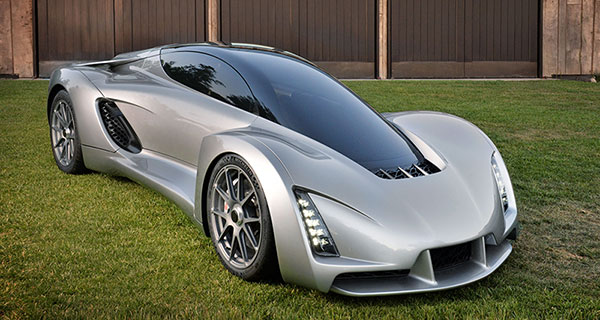Divergent Microfactories on Thursday introduced the world to the Blade, a 3D-printed supercar it designed as a proof of concept to spur the establishment of other microautomakers and reshape the auto industry.
Divergent Microfactories envisions microautomakers emerging similar to the way microbreweries have popped up across the U.S. It wants to “democratize the auto industry” by paving the way for dematerialized vehicles.
It’s 3D-printing technologies could make auto manufacturing affordable enough that new players can gain traction in the industry and drive forward an era of built-to-taste vehicles, the company maintained.
Micro automakers will have the capacity to deliver anywhere from a handful of cars to up to 10,000 per year, according to Divergent Microfactories.
To attract attention to this potential subsector of the auto industry, Divergent Microfactories designed and 3D-printed the Blade.
The Blade’s Cutting Edge
The bi-fuel Blade can run on gasoline or compressed natural gas. The supercar hit 60mph from standing in just two seconds, thanks to a 700-horsepower engine and an ultralight 1,400-lb build.
The Blade is based on Divergent Microfactories’ protected node technology. The company’s 3D-printed nodes, made of a metal alloy, join with carbon fiber tubes to create the Blade’s chassis. It’s the node technology that will enable small players to fabricate cars and scale production down within their reach, Divergent Microfactories said.
Along with kicking down the barriers of entry into the auto industry, Divergent Microfactories’ processes have less of an environmental impact than other means of auto manufacturing, according to the company.
Microautomakers could build their vehicles from just about any material, and the manufacturing process produces about a third of the emissions resulting from the manufacture of electric vehicles.
Divergent Microfactories literally rethought how to manufacture cars in low volume, and cheaply, noted Rob Enderle, principal analyst for the Enderle Group.
“This approach could return us to the 1930s, where there were a lot of small profitable custom carmakers in the market,” Enderle told TechNewsWorld. “They just had to rethink how to build cars using cutting edge 3D-printing techniques.”
Democratizing the Auto Industry
Whether or not new players pick up the node tech and microbrew their own flavor of dematerialized cars, there’s a sunny outlook for 3D printing in the auto industry, said Richard Hanna, global leader of automotive at PwC.
There was an exhibit of 3D-printed car parts at the Detroit Auto Show, and there already have been cars fabricated entirely through additive manufacturing, he noted.
“There are a lot of companies that are exploring specific applications, and I think there are certainly some good uses of 3D printing in the industry,” Hanna told TechNewsWorld.
As additive manufacturing works its way into the auto industry, engineers and project managers likely will weigh the prices and quality of 3D printing parts versus the landed cost of components manufactured in the traditional way, he said.
“In certain applications, it’s going to be cheaper to 3D print them,” Hanna observed, “and certainly, in the design stage, fast prototyping is a real advantage.”
3D printing requires no specific tools — just designs and raw materials — which is a significant advantage.
“When you’ve got very small runs and you’re doing prototypes, parts can sometimes be very expensive,” Hanna said. “With 3D printing, you don’t need the all of the tools.”
Despite the efforts at cost-cutting through additive manufacturing and Divergent Microfactories’ node tech, 3D-printed cars likely will become available first at the very top of the line, and it could be a long while before they trickle down within reach of the average consumer.
However, the current powerhouses in the auto industry each have “low-run high-end cars,” such as the Dodge Viper, and they could benefit from such an approach, suggested Enderle. “The end result would be far more interesting and affordable unique offerings in the luxury/supercar market than we have today.”




















































